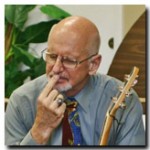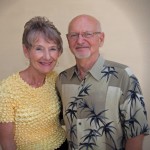
Naturalism, I think, is the culprit. Without using the word, we’re “naturalism” thinkers. And naturalism insists we understand the world in scientific terms. And science, even unintentionally, undercuts faith. That’s because faith calls us to believe in what we can’t see, while science operates in the seen realm. Consequently, “Scientists say . . . ” carries great authority and leaves the believer with his own private faith that “works” for him but carries no weight in the “real” world.
Randy Alcorn makes a compelling response . . .
“In The Silver Chair, C.S. Lewis tells how Puddleglum, Jill and Eustace are captured in a sunless underground world by an evil witch who calls herself the queen of the underworld. The witch claims that her prisoners’ memories of the overworld, Narnia, are but figments of their imagination. She laughs condescendingly at that child’s game of ‘pretending’ that there’s a world above and a great ruler of that world.
When they speak of the sun that’s visible in the world above, she asks them what a sun is. Groping for words, they compare it to a giant lamp. She replies, ‘When you try to think out clearly what this sun must be, you cannot tell me. You can only tell me it is like the lamp. Your sun is a dream, and there is nothing in that dream that was not copied from the lamp.’
When they speak of Aslan the lion, king of Narnia, she says they have seen cats and have merely projected those images into the make-believe notion of a giant cat. They begin to waver.
The queen, who hates Aslan and wishes to conquer Narnia, tries to deceive them into thinking that whatever they cannot perceive with their senses must be imaginary—which is the essence of naturalism. The longer they are unable to see the world they remember, the more they lose sight of it.
She says to them, hypnotically, ‘There never was any world but mine,’ and they repeat after her, abandoning reason, parroting her deceptions. Then she coos softly, ‘There is no Narnia, no overworld, no sky, no sun, no Aslan.’ This illustrates Satan’s power to mold our weak minds as we are trapped in a dark, fallen world. We’re prone to deny the great realities of God and Heaven, which we can no longer see because of the Curse.
Finally, when it appears they’ve succumbed to the queen’s lies, Puddleglum breaks the spell and says to the enraged queen, ‘Suppose we have only dreamed, or made up, all those things—trees and grass and sun and moon and stars and Aslan himself. Suppose we have. Then all that I can say is that . . . the made-up things seem a good deal more important than the real ones. Suppose this black pit of a kingdom of yours is the only world. Well, it strikes me as a pretty poor one. And that’s a funny thing, when you come to think of it. We’re just babies making up a game, if you’re right. But four babies playing a game can make a play-world which licks your real world hollow.’
The truth is exactly the opposite of naturalism’s premise—in fact, the dark world’s lamps are copies of the sun, and its cats are copies of Aslan. Heaven isn’t an extrapolation of earthly thinking; Earth is an extension of Heaven, made by the Creator King. The realm Puddleglum and the children believe in, Narnia and its sun and its universe, is real, and the witch’s world—which she tempts them to believe is the only real world—is in fact a lesser realm, corrupted and in bondage.
When the queen’s lies are exposed, she metamorphoses into the serpent she really is, whereupon Rilian, the human king and Aslan’s appointed ruler of Narnia, slays her. The despondent slaves who’ve lived in darkness are delivered. Light floods in, and their home below becomes a joyous place again because they realize that there is indeed a bright world above and Aslan truly rules the universe. They laugh and celebrate, turning cartwheels and popping firecrackers.
Sometimes we’re like Lewis’s characters. We succumb to naturalistic assumptions that what we see is real and what we don’t see isn’t . . . But we must recognize our blindness. The blind must take by faith that there are stars in the sky. If they depend on their ability to see, they will conclude that there are no stars . . .
We’ll one day be delivered from the blindness that separates us from the real world. We’ll realize then the stupefying bewitchment we’ve lived under.”
* * *
I don’t want to get into a science vs. faith debate. Suffice it to say that a true interpretation of Scripture and an accurate scientific discovery will coincide. But my point here is that “science” can subconsciously make us doubt the spiritual realm. Or it can leave us assuming we have to reject science if we’re to have faith in what we can’t see.
This problem arises especially for students. At any grade, how should they harmonize their science-learning with their faith? Or should they regard science and faith as forever separate realms, thus considering faith as anti-scientific and private?
C.S. Lewis creatively reminds us that instead of naturalism reigning supreme, naturalism (the only realm science can study) offers us only “copies” of what exists in the spiritual realm. And when all is said and done, the trinitarian God, whom we can’t see but whom we follow by faith, will have the last word. And his new creation will be immeasurably superior to anything naturalism provides. Puddleglum’s right.

 Monday of Holy Week dawns. Holy Week: from Sunday when Jesus “triumphantly” entered Jerusalem through Good Friday when Jesus was crucified, climaxing Sunday when he rose from the dead.
Monday of Holy Week dawns. Holy Week: from Sunday when Jesus “triumphantly” entered Jerusalem through Good Friday when Jesus was crucified, climaxing Sunday when he rose from the dead. Aberration: “a departure from what is normal.” Synonyms—“divergence, abnormality, rogue.” Now–the time in which we live–is an aberration.
Aberration: “a departure from what is normal.” Synonyms—“divergence, abnormality, rogue.” Now–the time in which we live–is an aberration.